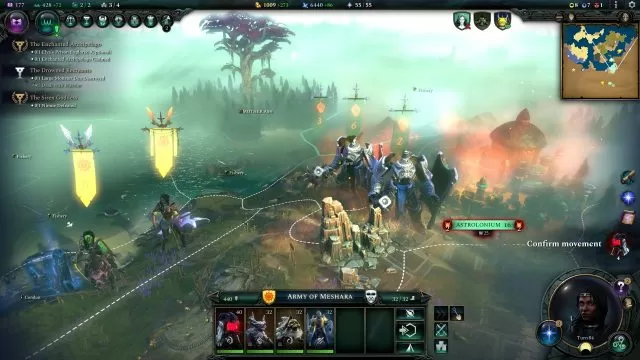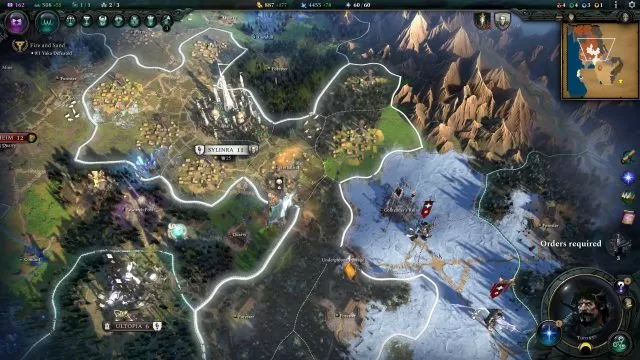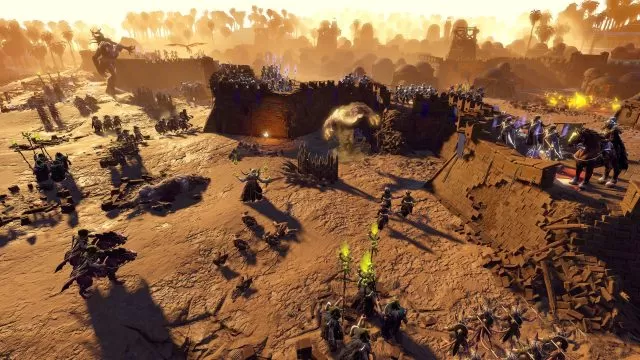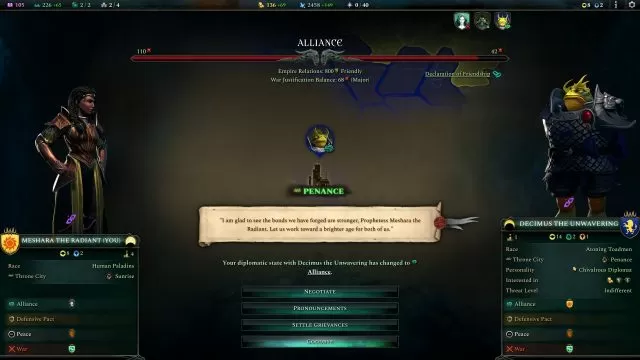Age of Wonders 4 Review – Positively Magical
Since the early days of tabletop gaming, a crucial prerequisite for fantasy role-players was imagination. The ability to weave stories and fly unshackled from the confines of reality was principally important for dungeon masters. Within the framework of established ruleset boundaries, good GMs always managed to conjure up volumes of weird improbabilities. The best among them bend the rules in such a way that no open-minded player would object. I fondly remember The Gnoll Bard’s Gambit, my GM friend’s bonkers scenario that we used to play in the early 2000s. It didn’t just bend the AD&D, it skewered some of its concepts and fried them over a spit. It was good, non-canonical, proper heretic fun.
By design, fantasy roleplay games and 4X strategies could never compete with wild, real-time human imagination. Until developers start to actively incorporate external AI services in their games, they will suffer from fixed pre-determinism. Emerging stories, limited by the processing power of a local CPU, will always be a cheap surrogate to the ones imagined by neural networks, either living or synthetic.
High Orcs and Barbarian Elves

The games like Age of Wonders 4 can help bridge the gap between the present and the future. This fourth iteration of the beloved turn-based fantasy 4X series offers unprecedented customization options, enabling the player to go wild with imagination. Stellaris, the closest comparison that comes to mind, has the same publisher, the venerable Paradox Interactive. Like its intergalactic counterpart, Age of Wonders 4 gives the players tools to completely control their experience from start to finish.
The ability to create open-ended factions with the potential for magical evolution is chief among those freedoms. You can freely mix and match physical form, culture, and societal traits, defying the established fantasy archetypes. Everybody knows about High Elves, but how about High Orcs, with the (shuffles cards…) penchant for seafaring and settling cities? Or barbarian Elves who engage in ritual cannibalism? Maybe industrious, empire-building Haflings? Or noble paladin Toadkin, feudal Goblins, or mystic, imperialistic Humans?
Your faction can further evolve during the game by accepting various magical boons, depending on the scenario script, gameplay circumstances, and your input. Decisions you make modify your alignment, often presenting you with dilemmas concerning your people. Will you end up giving everyone angelic wings, enabling your troops to fly over the terrain? Or perhaps the affinity for living underground? Evolution can also be initiated with a spell, related to quests or ancient wonders. Those are either fixed, if you play story maps, or completely random if you choose the self-designed map.
Unprecedented customization

Options for customizing the maps are too numerous to mention. There are literary HUNDREDS of possibilities to fine-tune everything, from geography, climate, inhabitants, wildlife, supernatural invasions, the size of the underworld, the number of AI factions, and other features. Miscellaneous characteristics offer additional flavor. “Domain of Mayhem”, for example, makes everyone bloodthirsty; Every faction you encounter will be hostile, and in tactical battles, all units will roll the berserk dice at every turn. “Disdain for Evil” makes every AI faction or free city accumulate grievances (more of that later) with evil-aligned empires. “Dragon territories” creates the map as a domain of dragons, triggering dragon infestations.
You can easily spend hours experimenting and tweaking the factions and maps before you even start playing. Fancy making a synergy between your people and the map, like placing seafaring, water-loving Toadkin in an archipelago? Or going the opposite way, putting cute amphibians into infernal landscape suffering from volcanic eruptions? The sky is the limit here, or rather, imagination. You can even opt for playing in simultaneous turns instead of classic turn-based mode. As in Stellaris, you get the solid collection of pre-baked races and maps by default – if for nothing else, those are useful as examples of how far can you go with experimenting.
Magic, warfare, and Fanfare

Like its predecessors, Age of Wonders 4 is fantasy 4X at its core. There is a lot of exploring, expanding, exploiting, and extermination. The game offers five story-based scenario maps, weaving the tale of magical reawakening, astral seas, and godlike figures, but you can honestly skip all that and play custom games. I would recommend familiarizing yourself with the system by playing tutorial scenario and leaving tooltip advice on. The game offers comprehensive learning resources and hyperlinked knowledge base, so you can accustom yourself to the complex systems as you go.
The combat ruleset is very similar to previous entries in the AoW series. Tiered troops, morale system, tactical casting, and other things are making a return. Troops are customizable with magic, which works best if they are paired with properly leveled commanders. For example, you can permanently enchant your melee troops to inflict lightning or fire damage, which uses some mana every turn, but works wonders with a commander who provides compatible damage bonuses to the troops.
Using a combination of might and magic (pun intended, ofc) and diplomacy, you will conquer or sweet talk your way to victory. There are three main victory conditions, military, expansion, and magic, which are essentially the same as in Age of Wonders III. Magic, of course, plays a crucial part in everything that’s happening here. There are numerous schools of magic, and strategic and combat spellcasting is an essential part of the game.
I wish to have it all

Diplomacy was expanded, and now, among other things have an interesting system of grievances. Those are, essentially, insults that affect your relationship with AI factions. Trespassing or claiming already claimed land, for instance, will cause grievance. Tightly related to grievances is the system of alignment – if you wage war on someone for no reason (no grievance), you will gradually shift into the evil spectrum, limiting the “good” branch of imperial development but opening up its opposite. All this is a part of the faction evolution I mentioned earlier.
I forgot to mention Pantheon. There’s a layer of experience acquired by every victory and loss, which unlocks permanent stuff, cosmetic at first, but more useful in later tiers. Post-game, every successful commander can ascend into Pantheon and become eligible to appear in subsequent games. This meta layer builds slowly but is a permanent reminder of your time and effort invested.
Age of Wonders 4 is bristling with options and opportunities but has a hard cap on possibility. This is, simply put, an awesome game that is fundamentally limited in what it can become. The typical session can never take off, evolve and mutate in the same way as Civilization games can. You will not be hard-pressed to fundamentally change how you think about warfare or economy, there’s no oil to be found, no flight to be discovered, and no nukes to scare everyone with. I realize that some people might find this complaint stupid, but I would, personally, like to have it all. In other words, I would prefer to play with all the ages instead or just fourth. It’s definitely something to contemplate for the fifth installment.
Highs
- Unprecedented freedom of customization.
- Pantheon feature enables meta-game longevity.
- Probably the best 4X fantasy game out there.
Lows
- Some bugs regarding stability in story missions.

